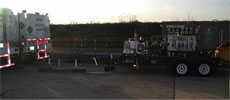Recycling helium and argon for future experiments
 |
| This portable compressor allows PPD to store recycled gas for future experiments. Photo: John Voirin, PPD |
Recycling is important at Fermilab. We reuse at every opportunity in order to push science further while keeping costs down.
A recent and successful example of our scientific recycling is the fluid preservation for MINERvA. The neutrino experiment is used to examine neutrino interactions, the study of which could lead to an understanding of why there is an imbalance of matter and antimatter in the universe.
MINERvA's detector uses a cryogenic target filled with more than 2,200 liters of liquid helium. The NuMI beam provides neutrinos, which strike the helium target. Scientists then study the way the neutrinos interact with the helium nuclei.
Helium is a non-renewable resource, and it is becoming more expensive.
Last fall the PPD Detector Development & Operations Installation crew installed the cryostat and filled it with liquid helium. The target ran uninterrupted for over six months. When the run ended, scientists needed to empty the target to fill it with a new liquid for the next step of the experiment.
"Helium can be vented to the atmosphere safely," said Jim Kilmer, associate head of PPD Detector Development and Operations. "But I thought venting would be wasteful."
Kilmer procured a portable, high-pressure compressor from the railhead storage area at the north end of Fermilab. The compressor was built in 1995 to recover helium from a different experiment, where it ran over a year. Pat Healy, a senior technical aide from DZero operations, rebuilt the compressor system completely.
After rebuilding and setting the compressor up at the MINOS service building, Bob Sanders of PPD Mechanical Engineering recovered nearly all of the helium. It was converted from its liquid form to a gas, and was then pumped into two tube trailers for storage. The Accelerator Division will use this helium in their daily operations. The value of the recycled gas is about $20,000.
The compressor was also used to recover argon from the Liquid Argon Purity Demonstration. The LAPD successfully purified liquid argon and achieved long electron lifetimes in a non-evacuated, industrial tank.
The PPD crew used the compressor to recover the argon once it was converted into gas. They recovered 7,600 pounds of gas, compressing them into two tube trailers. The argon gas has a value of $7,000, said Richard Schmitt, Process Engineer for the PPD Mechanical Engineering Department.
The recovered gas will be used in the Super Cryogenic Dark Matter Search detector. We plan to use the compressor for scientifically recycling gases for other experiments in the future.
—John Voirin, Group Leader, PPD Experiment Installation
|